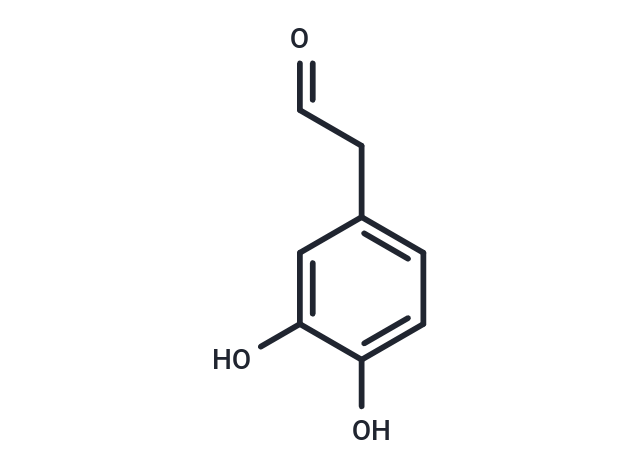 Your shopping cart is currently empty
Your shopping cart is currently empty

DOPAL is an aldehyde product of the oxidative deamination of dopamine by monoamine oxidase.[1] It can be further oxidized to 3,4-dihydroxyphenylacetic acid (DOPAC) by aldehyde dehydrogenase (ALDH) and, to a lesser extent reduced to 3,4-dihydroxyphenyl ethanol (DOPET). DOPAL is toxic to neurons.[2],[3] It can also oligomerize and precipitate α-synuclein, an event associated with Parkinson's disease.[2] Mice lacking cytosolic and mitochondrial forms of ALDH display increased levels of DOPAL as well as neurodegeneration and motor dysfunction characteristic of Parkinson's disease.[4]

| Pack Size | Price | USA Warehouse | Global Warehouse | Quantity |
|---|---|---|---|---|
| 5 mg | $196 | 35 days | 35 days | |
| 10 mg | $368 | 35 days | 35 days |
| Description | DOPAL is an aldehyde product of the oxidative deamination of dopamine by monoamine oxidase.[1] It can be further oxidized to 3,4-dihydroxyphenylacetic acid (DOPAC) by aldehyde dehydrogenase (ALDH) and, to a lesser extent reduced to 3,4-dihydroxyphenyl ethanol (DOPET). DOPAL is toxic to neurons.[2],[3] It can also oligomerize and precipitate α-synuclein, an event associated with Parkinson's disease.[2] Mice lacking cytosolic and mitochondrial forms of ALDH display increased levels of DOPAL as well as neurodegeneration and motor dysfunction characteristic of Parkinson's disease.[4] |
| Molecular Weight | 152.15 |
| Formula | C8H8O3 |
| Cas No. | 5707-55-1 |
| Smiles | O=CCC1=CC=C(O)C(O)=C1 |
| Storage | store at low temperature | Powder: -20°C for 3 years | In solvent: -80°C for 1 year | Shipping with blue ice/Shipping at ambient temperature. | ||||||||||||||||||||||||||||||
| Solubility Information | Ethanol: 15 mg/mL (98.59 mM), Sonication is recommended. DMSO: 10 mg/mL (65.72 mM), Sonication is recommended. DMF: 15 mg/mL (98.59 mM), Sonication is recommended. | ||||||||||||||||||||||||||||||
Solution Preparation Table | |||||||||||||||||||||||||||||||
DMSO/Ethanol/DMF
| |||||||||||||||||||||||||||||||
| Size | Quantity | Unit Price | Amount | Operation |
|---|

Copyright © 2015-2026 TargetMol Chemicals Inc. All Rights Reserved.